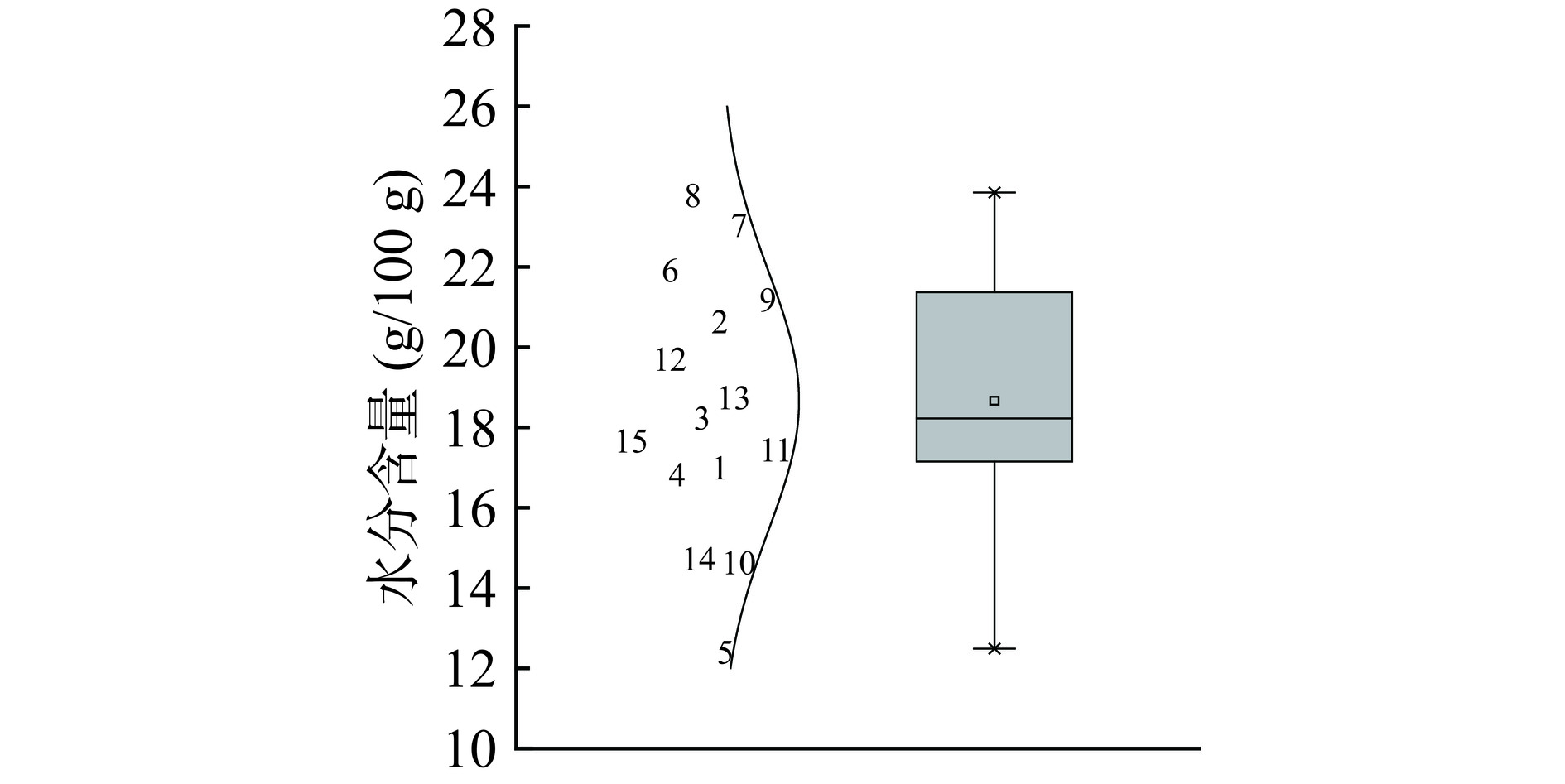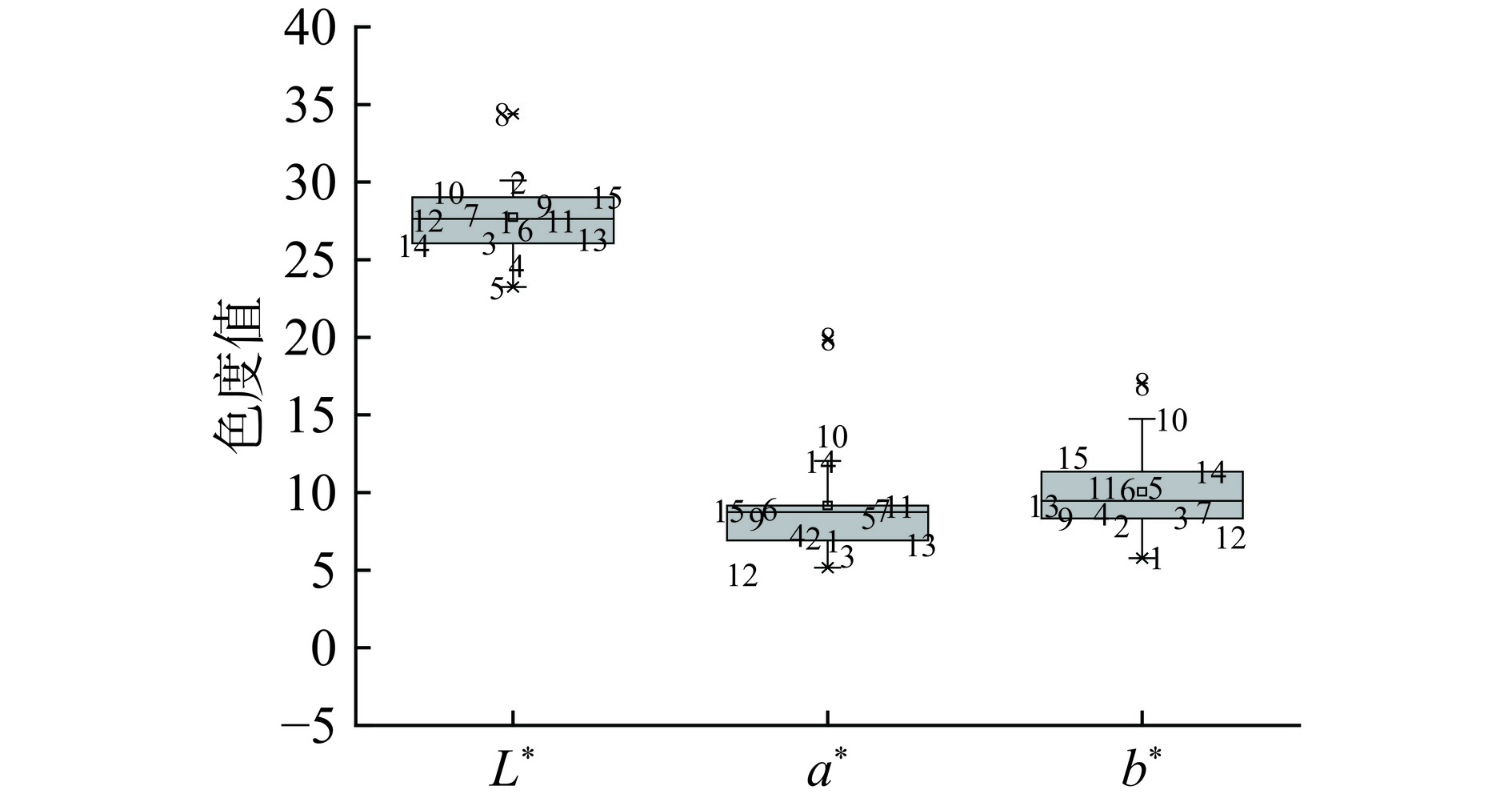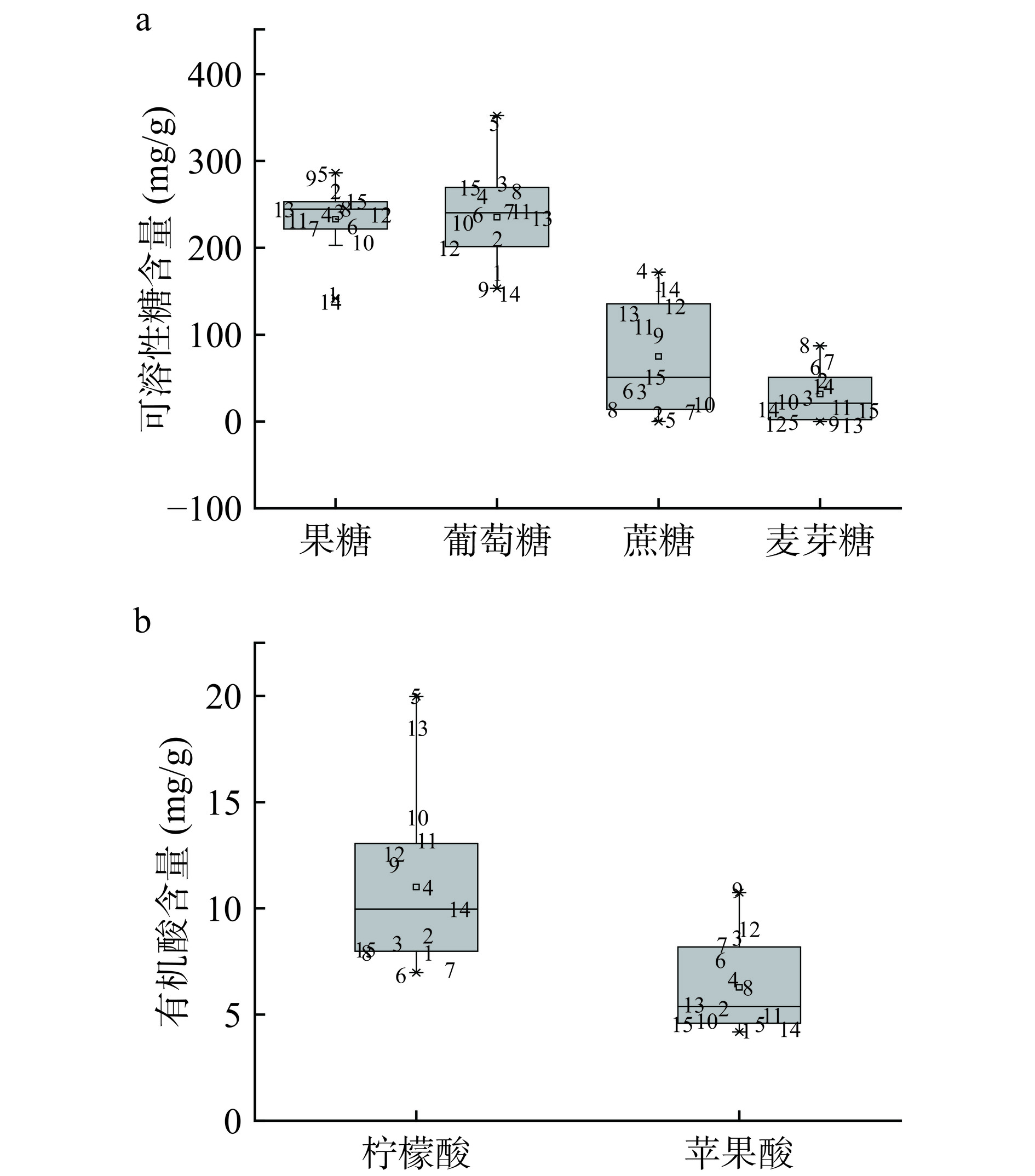Analysis of Quality Property Variations in Commercial Candied Strawberries
-
摘要: 为了解目前市售草莓脯的品质特点,本文对15个品牌草莓脯产品的色泽、质构及糖酸含量等理化指标分别采用色差计、质构仪和高效液相色谱进行了测定,并采用强度标度法对感官特性进行了评分。结果显示:草莓脯的水分含量为12.49%~23.86%,色度值L*值分布于23.25~34.39,a*值5.17~19.83,b*值5.78~17.04;质构参数中硬度、咀嚼性和粘力差异显著(P<0.05)。草莓脯中可溶性糖主要为果糖、葡萄糖,二者分别为总糖的30.17%~52.43%和28.49%~55.15%,蔗糖和麦芽糖含量略低,不同样品间差别较大,分别为总糖的0.00%~33.00%和0.00%~14.08%。有机酸以柠檬酸和苹果酸为主,分别为7.98~13.05 mg/g和4.48~8.17 mg/g。感官评分结果显示色泽、粘度与整体接受度变幅较大。对草莓脯及品质指标进行双向聚类发现样品聚为2类而品质指标聚为3组。类别I中的草莓脯因具有较高的a*、b*、弹性值与感官色泽、粘度、整体接受度评分而与类别II中的样品区分,说明草莓脯品质差异主要体现为色泽与粘度差异。另外,由指标聚类结果可知,柠檬酸、葡萄糖和果糖含量与咀嚼性相关;麦芽糖、蔗糖、水分含量与粘力相关。研究结果为草莓脯产品的质量评价与品质调控提供方向。Abstract: The purpose of this study was to discover the quality properties of the commercially available candied strawberries. Fifteen samples with different brands were purchased, and the physicochemical parametes, such as color, texture, sugar and acid content were determined using colorimeter, texture analyzer and HPLC. In addition, sensory scores were evaluated using intensity scale method. The results showed that the moisture content of these preserved strawberries were between 12.49% and 23.86%, and the colorimetric values distribution ranges of L*, a* and b* were 23.25~34.39, 5.17~19.83, and 5.78~17.04, respectively. For the texture characters, there were significant differences (P<0.05) in hardness, chewiness, and adhesive force between the samples. Fructose and glucose were the major soluble sugars in the samples, and they contributed 30.17%~52.43% and 28.49%~55.15% for the total sugars, respectively. While less content of sucrose and maltose were detected, which contributed 0.00%~33.00% and 0.00%~14.08% for the total sugars. Moreover, citric acid and malic acid were the main organic acids, and their contents were 7.98~13.05 mg/g and 4.48~8.17 mg/g, respectively. For the sensory scores, color, viscosity, and overall acceptance showed larger dispersions. Using double-way cluster analysis, the samples were separated as two clusters and the quality properties were clustered into three groups. The samples in cluster I obtained higher values of a*, b*, and springiness, as well as higher sensory scores of color, viscosity, and overall acceptance, which separated them with the samples in cluster II, illustrating that the quality difference of the candied strawberries were focused on the color and texture characters. In addition, the clustered results of the quality parameters showed that close relationships among citric acid, glucose and fructose content with chewiness. Similarly, maltose, sucrose and water content associated with the viscosity. These study results provided a direction for the quality discrimination and control of candied strawberries.
-
草莓脯是近些年来出现于市场的新型果脯品类,因其软糯香甜等特点而广受消费者欢迎。在淘宝上搜索草莓干/果脯,可出现2000多条结果,产地遍布江浙沪皖、川陕、晋冀鲁豫、闽粤桂滇等各省,一些知名休闲零食品牌也纷纷将其作为重点发展的产品。但是,不同品牌甚至同一品牌不同批次的草莓脯颜色、外形乃至风味口感均可出现明显差异,这种差异降低了消费者对该类产品的认可度,难以形成消费忠诚度[1],进而影响了产业发展。
为提高果蔬产品品质的稳定性,有效实现质量控制,往往需要对原料[2]、配料[3]、工艺[4−5]、贮藏包装[6]等进行标准化与规范化,并设定针对性的检测指标[7]。但是,我国尚无草莓脯制品的产品标准与生产规范,相关的有GB/T 10782-2021《蜜饯质量通则》以及NY/T 436-2018《绿色食品 蜜饯》,这两个标准将蜜饯进行了分类,根据此标准,草莓脯属于果脯类,以水分和总糖含量为理化指标。但是,草莓为花托发育的假果[8],为聚合果,其组织结构不同于用于制作经典传统蜜饯的李杏等核果类果实,也不同于葡萄、柿子等浆果,最新的研究发现渗糖[9]、干燥[10]、贮藏[11]过程均会对草莓脯色泽、质地、风味、营养等品质产生显著影响。因此,确定市售产品品质指标变异范围并确定与感官接受度的关系,对于进一步从原料、工艺等角度开展质量调控和加工规范的制定具有重要的意义。
研究选购了多个产地不同配料及品牌的15个市售草莓脯产品,对其色差、质构、游离糖和有机酸含量等理化指标与色泽、质地、滋味等感官指标进行了测定,对不同指标值分布区间及样品间差异进行了比较与分析,考察了理化品质差异与感官接受度之间的关系,从而为草莓脯产品的质量评价与控制提供借鉴。
1. 材料与方法
1.1 材料与仪器
15种草莓脯 市售,品牌整果编号分别为1~15,执行标准除原产泰国的5号样品外,均标注为GB/T 10782,其余主要信息见表1,指标测定时产品均在保质期内;果糖、葡萄糖、麦芽糖、蔗糖、苹果酸、柠檬酸、磷酸二氢钾 国药集团化学试剂有限公司;甲醇、乙腈 美国天地(TEDIA)化学试剂公司。
表 1 草莓脯样品信息表Table 1. Information list of candied strawberries编号 产地 产品宣传点 配料及食品添加剂 保质期(月) 1 山东 配料 白砂糖、食盐 4 2 辽宁 原料、工艺 白砂糖 12 3 山东 包装 白砂糖 8 4 山东 无添加 白砂糖 6 5 泰国 无添加 无标注 3 6 山东 品种为蒙特瑞 白砂糖、麦芽糖浆、柠檬酸、焦亚硫酸钠、胭脂红、香精 8 7 山东 工艺 白砂糖、麦芽糖浆、柠檬酸、焦亚硫酸钠、胭脂红、乳酸钙、香精 12 8 浙江 原料 白砂糖、柠檬酸、焦亚硫酸钠、胭脂红、香精 12 9 山东 原料 白砂糖、柠檬酸、焦亚硫酸钠、胭脂红、香精 10 10 河北 配料 白砂糖、海藻糖(添加量8.7%)、柠檬酸、乳酸钙、焦亚硫酸钠、胭脂红、香料 12 11 江苏 工艺 白砂糖、麦芽糖浆、柠檬酸、焦亚硫酸钠、胭脂红、香精 9 12 广州 无 白砂糖、食盐、柠檬酸、糖精钠、甜蜜素、阿斯巴甜(含苯丙氨酸)、山梨酸钾、香料 12 13 福建 原料 白砂糖、麦芽糖浆、柠檬酸、乙基麦芽酚、焦亚硫酸钠、胭脂红、香精 9 14 浙江 原料 白砂糖、麦芽糖浆、柠檬酸、胭脂红、山梨酸钾、焦亚硫酸钠、香精 12 15 江苏 无 白砂糖、麦芽糖浆、柠檬酸、焦亚硫酸钠、胭脂红、香精 9 TG16-WS台式高速离心机 上沙湘仪离心机仪器有限公司;TU-1810紫外可见分光光度计 北京普析通用仪器有限公司;QTS型质构仪 英国CNS Faemell公司;DGH-9073B5-III型电热恒温鼓风干燥箱 上海新苗医疗机械制造有限公司;安捷伦1200高效液相色谱仪 美国Agilent公司;HH-8数显恒温水浴锅 上海江星仪器有限公司;WSC-S型色差仪 上海精密科学仪器有限公司;KH-500D型数控超声波清洗器 昆山禾创超声仪器有限公司。
1.2 实验方法
1.2.1 样品预处理
将各草莓脯样品每种取约20 g(8~10颗),剪碎混合用于水分、可溶性糖和有机酸的测定。
1.2.2 水分含量测定
参照GB 5009.3-2016第一法直接干燥法,测定草莓脯中水分含量,以5.00 g剪碎草莓脯进行重复3次测定,取平均值。
1.2.3 色度测定
以色差仪测定草莓脯表面色度值,采用L*、a*、b*测定模式,其中L*为亮度值,a*值为红值,b*值为黄值。每种草莓脯测定6颗作为重复,每颗测定3次平行,取平均值。
1.2.4 全谱图质构分析(TPA)
参照胡丽丽等[12]对草莓脯质构测定的研究结果,采用从草莓脯中心部位沿纵轴方向上下各0.25 cm切取果段,将截面为受力面进行质构分析。TPA测定采用TA11/1000探头(Cylinder 25.4 mm D,35 mm L)。测定参数设置为:1.0 mm/s,触发力为5 g,压缩距离为5 mm,循环次数为2次。每种草莓脯选择10颗重复测定。
1.2.5 可溶性糖及有机酸含量的测定
参照文献[9]的方法进行。称取切碎的草莓脯0.50 g,加入5 mL蒸馏水研磨匀浆,转移至离心管,在50 ℃、100 W超声条件下水浴90 min后在9000 r/min下离心8 min,取上清液−18 ℃冻藏,待高效液相色谱分析用。每个样品3次重复取样,每个重复进行2次平行测定。
可溶性糖测定:吸取提取液0.2 mL,加入0.2 mL乙腈,旋涡混匀过0.45 μm有机膜,用于高效液相色谱分析。采用Agilent Zorbax Carbohydrate色谱柱(150 mm×4.6 mm,5 μm),1260示差折光检测器(RID),流动相为乙腈:水=75:25(V:V),流速0.8 mL/min,检测器和柱温均为30 ℃,进样量为20 μL。通过与果糖、葡萄糖、蔗糖和麦芽糖标准样品保留时间比对进行定性,外标法定量。
有机酸测定:吸取提取液0.4 mL过0.45 μm有机膜,用于高效液相色谱分析。采用ZORBAX Eclipse XDB-C18色谱柱;流动相0.1% KH2PO4:甲醇=96:4(V:V),流速1 mL/min,柱温25 ℃,二极管阵列检测器(DAD),λ=214 nm,进样量20 μL。通过与柠檬酸、苹果酸标准样品比对进行定性,外标法定量。
1.2.6 感官评定
参考GB/T 16290-1996《感官分析 方法学 使用标度评价食品》,感官描述词及标度如表2所示。由15名食品专业感官评价员进行,年龄25~45岁,其中男性4名,女性11名,均熟悉新鲜草莓的色泽及风味,多次参评果蔬干燥产品感官评价。评分采用五点强度标度法,样品测评分三天进行,每天评价5种样品。
表 2 感官分析的描述词及定义Table 2. Sensory attributes and definitions描述词 定义 强度标度 色泽 自然光下,白色纸盘上观察草莓脯表面的色泽 1-过黑过暗;2-偏黑偏暗;3-色泽红润,接近草莓原色正常;4-色泽偏淡;5-色泽过于明亮/艳丽 粘度 样品置于拇指和食指中指间,手指分开时需要的力 1-很黏;2-能感觉到粘;3-润泽不粘;4-偏干;5-干且有砂感 硬性 样品置于上下切牙间,咬断时需要的力 1-过硬;2-偏硬;3-软硬适中;4-偏软;5-太软 滋味 咀嚼和吞咽过程中体会到的酸度和甜度 1-太酸;2-偏酸;3-酸甜适度;4-偏甜;5-太甜 整体评价 品尝后对草莓脯的喜爱程度 1-很讨厌;2-不喜欢;3-可以接受,谈不上喜欢不喜欢;4-有点喜欢;5-非常喜欢 1.3 数据处理
箱线图采用Origin 2016绘制,显示数据最大值、最小值、中位数和两个四分位数,用于反映数据分布的范围与离散性。差异显著性分析采用SPSS16.0进行单因素方差分析,P<0.05为差异显著。采用JMP10.0将数据标准化后采用ward法进行层次聚类分析。
2. 结果与分析
2.1 草莓脯的水分含量
果脯作为水果脱水产品,仍含有一定的水分,如无花果干含有21%~34%的水分[13]。图1为15种草莓脯水分含量分布的箱线图。15种草莓脯的水分含量为12.49%~23.86%,含水量最低的为5号,最高的为8号。其中中箱内数据即50%的样品水分含量分布于17.15%~21.37%,所有样品的平均值为18.66%。水分含量为蜜饯质量要求的重要指标,GB/T 10782-2021蜜饯质量通则中要求果脯类产品水分含量≤35%,在常见的水果干制品中,NY/T705-2003无核葡萄干要求葡萄干水分含量≤15%,桃脯(GH/T 1148-2021)、杏脯(GH/T 1156-2021)的水分含量则要求≤23.00%。草莓脯的水分含量与上述其他果脯标准中的要求基本一致。水分的变化与产品口感密切相关,冯作山等[14]认为失水是新疆果脯返砂的关键因素,除水分含量外,水分活度[15]、持水性[16]等特性也可能与草莓果脯品质密切相关,值得进一步研究。
2.2 草莓脯的色泽分析
如图2所示,样品 8的L*、a*、b*值均为最高值,并表现为离群值。其次为样品10,其三个色度值均与样品8最为接近,经核查发现二者虽然属于不同的品牌,但生产厂家均在河北省,说明二者可能采取了相似的产品原料与加工工艺。另外,样品8的水分含量最高,与样品10差别较大(图1),这可能反映了水分对样品色泽的影响较弱。样品11与15的L*、a*、b*值数值接近,并且水分含量也接近(图1),二者来自同一个生产厂家(不同委托方),说明同一厂家为不同品牌供应的产品质量具有一定的相似性。样品4和5的亮度值L*最低,与其宣称的无添加加工方式(表1)以及颜色棕黑色一致。12号的a*、b*值均偏低,其次为1、2、3。样品6为销量大的电商品牌,其L*、a*、b*值均接近色差值的中值。
综合分析所有样品的三个色度值,L*值分布于23.25~34.39,a*值5.17~19.83,b*值5.78~17.04。a*值的变化幅度最大,最高值为最低值的3.83倍,其次为b*值,这与报道中草莓脯的a*值变化最为敏感[11]一致。工艺条件会显著影响色泽,如Changrue等[17]研究发现渗透脱水预处理对草莓干制品L*的影响最大,微波干燥的能量程序设置对整体色泽变化影响显著(P<0.05)。草莓脯样品的a*值为正,说明草莓脯呈现红色,草莓中的红色物质花色苷不稳定,在糖渍过程中会大量流失[9],往往采用胭脂红对色泽进行了调整(表1),因此草莓脯的色泽应为内源呈色成分与色素的综合体系。另外,草莓脯在贮藏过程中,会发生明显的色泽变化,L*、a*、b*值降低[11]。总体而言,原料、工艺、贮藏时间与条件对草莓脯色泽的影响均不可忽略。
2.3 草莓脯的质构分析
如表3所示,15个草莓干样品的TPA质构参数中,内聚性和弹性未表现出显著差异(P>0.05),而硬度、咀嚼性和粘力则差异显著(P<0.05)。质构仪测定的咀嚼性的数学定义为硬度、内聚性和弹性的乘积,感官定义为咀嚼固体样品至吞咽前所需的能量,硬度为压缩至设定距离时所需的力,在不同食品中硬度和咀嚼性往往呈正相关关系[18−19]。测定草莓脯样品的内聚性和弹性未表现出显著差异,那么硬度和咀嚼性数值的高低也呈现一致性。但是,粘力为探头表面与果脯表面分离时需要的力,为第一次压缩循环时最大的负向作用。因此,硬度、咀嚼性和粘力值的差异说明草莓脯质地的差异不仅体现在内部结构上,也体现在表面吸附特性上,而这种差别可能与表面糖的结晶[20]或吸湿[21]有关。硬度值和咀嚼性最高的均为样品13,最低值均为样品8,两个指标最高值和最低值的比值分别为5.46和5.26。粘力值最高的为样品12与1,粘力值高于20.00 g,其次为9、2、3、13、8,粘力值为8.80~12.80 g,最低值为样品5,其粘力值仅为样品12的18.82%。来自同一生产厂家的样品11与15在质构参数上未表现出显著差异(P<0.05),说明其产品的一致性。整体而言,相比水分含量与色度值,不同样品的质构特性差别更大,并主要体现在硬度和粘力上。
表 3 15种草莓脯的质地特性Table 3. TPA parameters of the 15 candied strawberry samples编号 硬度(g) 内聚性 弹性(mm) 咀嚼性(mJ) 粘力(g) 1 731.60±35.76efg 0.69±0.03a 1.49±0.1a 7.60±1.14cde 20.80±2.28a 2 580.40±121.2 fg 0.74±0.00a 1.74±0.14a 6.52±1.63de 12.20±2.86bc 3 1398.20±370.11b 0.65±0.12a 1.43±0.17a 12.14±4.10bc 11.28±1.75bcd 4 534.60±152.17 fg 0.70±0.05a 1.55±0.17a 5.71±1.55 de 5.80±1.79ef 5 1079.60±300.3 bcde 0.67±0.06a 1.44±0.14a 9.60±2.88bcd 4.29±0.65f 6 686.80±73.34efg 0.74±0.03a 1.56±0.15a 7.56±1.21de 5.60±2.07ef 7 379.24±31.17g 0.69±0.05a 1.27±0.30a 3.73±0.04e 5.60±1.67ef 8 366.00±38.42g 0.66±0.02a 1.47±0.07a 3.52±0.51e 8.80±1.92bcdef 9 636.20±121.95fg 0.67±0.05a 1.60±0.21a 6.81±2.46de 12.80±2.28b 10 1270.80±246.6bc 0.62±0.06a 2.72±2.16a 8.94±0.96bcd 8.00±1.58cdef 11 893.12±92.85cdef 0.60±0.08a 1.42±0.18a 7.46±2.03de 6.80±2.68def 12 1116.13±142.5 bcd 0.67±0.04a 1.71±0.35a 12.31±3.38b 22.80±2.28a 13 1999.47±84.6a 0.66±0.03a 1.42±0.07a 18.52±0.76a 9.20±2.68bcde 14 1447.30±266.78b 0.65±0.14a 1.35±0.32a 9.30±1.18bcd 6.20±2.28ef 15 887.84±189.14cdef 0.57±0.09a 1.34±0.24a 7.30±1.94de 5.80±1.46ef 注:同列不同上标字母者表示差异显著(P<0.05)。 质构特性是脱水果蔬的重要特性,脱水过程往往可导致细胞破裂崩塌、组织收缩等现象而出现质地过硬或不均匀等问题,如何提高质地特性也是近年来脱水果蔬研究重点,质构特点与原料细胞壁结构及多糖密切相关[22−23],加糖是促进良好质构形态形成的最常用的方法,不同的糖或糖醇对质构的影响很大[24]。如表1中,草莓脯样品配料中糖的添加种类是有所不同的,除白砂糖(蔗糖)外,麦芽糖和海藻糖也出现在了配料表中,另外大多品牌均在宣传材料中强调了草莓原料的重要性,说明原料特点和外源糖的作用均为影响质构的重要因素。
2.4 草莓脯中可溶性糖与有机酸组成
由图3可知,草莓脯样品中可溶性糖以果糖、葡萄糖为主,含量范围分别为141.92~286.47 mg/g和153.43~352.24 mg/g,而蔗糖和麦芽糖含量偏低,分别为0~172.02 mg/g和0~87.16 mg/g。草莓脯中有机酸则主要为柠檬酸和苹果酸,柠檬酸含量主要分布于7.98~13.05 mg/g,苹果酸含量主要分布于4.48~8.17 mg/g。
15个样品中,不同样品的糖和有机酸的组成和含量差别很大。5号的果糖与葡萄糖含量均为最高,分别为286.47和352.24 mg/g,但未检测到蔗糖,也是15个样品中唯一一个未检测到蔗糖的样品;1和14号果糖和葡萄糖的含量均为最低值,但二者的蔗糖含量偏高;样品中麦芽糖含量普遍为含量最低的游离糖,但是在蔗糖含量(0.44~3.24 mg/g)偏低的5个样品(2、5、6、7、8)中,麦芽糖含量高于蔗糖,有可能是因为加工中采用麦芽糖部分取代了蔗糖。草莓脯样品中,5号柠檬酸含量最高(19.97 mg/g),6号最低(6.69 mg/g);9号苹果酸含量最高(10.74 mg/g),14号最低(4.17 mg/g)。5号样品是唯一一个非国内加工的产品(表1),糖和有机酸组成的与众不同可能说明其工艺配方等均与国内产品存在差别。
在推荐标准GB/T 10782-2021中,蜜饯分为7类,其中要求果脯中总糖含量≤85%。将15个样品中检测到的可溶性糖含量求和,计算得到总糖含量在470.40~729.60 mg/g,与标准对糖含量的要求相符。样品中4号的总糖含量最高并表现为蔗糖的含量最高(172.02 mg/g),由于蔗糖是果脯加工中最常用的配料,有可能说明该样品对于外源蔗糖的吸收能力较强[9],从而提高了总糖含量。
新鲜草莓中的可溶性糖主要为果糖、葡萄糖和蔗糖,有机酸则主要为柠檬酸和苹果酸[25−28]。不同品种的草莓中,糖和有机酸的组成存在显著差异,并和成熟度密切相关[26,28],大多草莓中果糖和葡萄糖含量较高,蔗糖含量较低,有机酸则主要为柠檬酸,其次为苹果酸,柠檬酸含量可为苹果酸的4.90倍[26]。在李佳秀等[25]测定的10个草莓品种中9个品种的果糖和葡萄糖含量均高于蔗糖,仅有南方红颜的蔗糖含量较高,白胜等[26]也报道了类似的结果,测定的7个草莓品种中仅红颜的蔗糖含量高于葡萄糖和果糖,且有的品种蔗糖含量很低,仅为1.70 mg/g。市售草莓脯中6号宣传中介绍所用品种为蒙特瑞,据报道蒙特瑞为欧美品种,具有酸含量高、糖含量低的特点,其有机酸含量可达红颜和甜查理的10倍[29]。另外,草莓经糖渍烘干制作为草莓脯的过程中,蔗糖(白砂糖)、麦芽糖往往为最常用的配料,柠檬酸为最常用的食品添加剂(表1)。在糖渍过程中,草莓自身成分与糖渍液中的糖和有机酸存在交换与往复渗透作用[9],并且蔗糖会发生水解,每分子的蔗糖可转化为一分子的果糖以及一分子的葡萄糖[30]。因此,最终草莓脯中糖酸的含量体现的是浸渍液中糖酸等成分形成的渗透压与和草莓组织阻力与吸附力形成的平衡[9]。另外,市售草莓脯的保质期通常在3个月到12个月不等(表1),在贮藏过程中糖酸含量可能随时间延长而下降,并存在蔗糖向还原糖的转化以及羰氨反应造成的糖的消耗等过程[11]。因此,草莓脯中游离糖含量和组成成分为原料、工艺、贮藏期综合影响的体现。
2.5 草莓脯的感官评价
对15种草莓脯的感官评分如图4所示。可以看到在评价的色泽、粘度、硬性、滋味、整体接受度这5个感官属性中,硬性和滋味的评分最为集中,色泽和粘度评分则离散度较大,整体接受度也出现较大的离散度。对比15个样品,硬性评价中,评分为3的样品有8个,说明草莓脯软硬度适中,仅有样品13偏硬,评分为1.86,样品3偏软,达3.50。同样大多样品酸甜适中,仅有1、2、14号偏甜(评分>3),5号偏酸(评分为1.6)。色泽评分从1.00~3.68,低于3.00的样品有7个,并且评分没有高于4的,说明草莓脯颜色以偏黑色偏暗至草莓红色为主。粘度的评分数据分布与色泽相似,均为上窄下宽的箱型图,并且数值范围接近,分布于1.00~3.52,15、10、14、6几个样品得分均大于中位值,12的得分偏低。在整体接受度评分中,评分偏低的有1、2、13号,这三个样品均为表皮偏粘的样品,另外1、2偏酸,3的色泽偏暗,13则是表面砂感的样品,这说明滋味偏酸、色泽偏暗、表皮过粘或过干都会降低整体感官评分;接受度评分高于4的样品有6、8、10,这三个样品的共同特点为在色泽、粘度的评分均高于中位值,硬性和滋味评分则均接近3,即软硬和酸甜度适中。综合感官评定结果,说明不同市售草莓脯在硬性和滋味上差别小,换言之产品的硬性和滋味更易控制,而色泽和粘度差别大,说明这两点是其质量差异的主要体现,并且色泽偏黑、表皮发粘是草莓脯整体接受度降低的主要原因[31]。许利平等[32]对10个草莓品种的感官品质进行了调查,不同品种的果型、颜色、酸甜度、硬度上存在差异,认为蒙特瑞酸度和硬度大适合加工,与胡丽丽[29]对3个品种在草莓脯加工适性评价的结论一致。但是如何实现以及草莓脯的感官需求建立对应的草莓原料筛选指标及数值范围,仍待进一步研究。
2.6 草莓脯品质指标间的相关性分析
对测定的指标和样品双向聚类的结果如图5所示。15个样品聚为两类:1、2、4、6、7、3、12、9、8的9个样品聚为类别I;其他6个样品聚为类别II。所有指标可以分为3组:1组:色泽、接受度、a*值、b*值、弹性、粘度;2组:硬度、咀嚼性、柠檬酸、果糖、葡萄糖;3组:硬性、苹果酸、L*值、水分、内聚性、麦芽糖、滋味、粘力、蔗糖。样品分为两类,其区别主要体现在类别I中的样品第1、3组指标值较高(红-黑色为主),第2组指标值偏低(黑色-绿色为主)。鉴于所有样品中弹性差异不显著(P>0.05)(表3),由第1组指标组成可以推测与整体接受度最为相关的指标主要为色泽与粘度。第2组指标中硬度和咀嚼性均为质构仪测定的指标,具有良好的相关性[18−19],而柠檬酸可促进蔗糖转化为果糖和葡萄糖[30]。另外柠檬酸对果干质地也具有显著的作用[33],所以这组指标应该体现了转化糖与质地的关系。第3组指标又可以分为3小组,其中硬性和苹果酸聚为一小组,苹果酸来自于草莓本身[25−28],其和硬性的相关性可能反映了草莓自身特性与其口感质地的相关性;L*、水分、内聚性、麦芽糖距离较近,鉴于麦芽糖的吸湿性[21]与共色作用[3],可以认为外加麦芽糖更有助于保持草莓脯的水分并影响质地和色泽;滋味、粘力和蔗糖聚集,说明蔗糖作为常用的果脯加工辅料,除对草莓脯的滋味调整有重要的作用外,也与产品的粘力有关。
3. 结论
不同品牌的草莓脯的水分与糖含量均符合GB/T 10782要求。不同草莓脯的色泽参数中,a*值的变化幅度最大;质构参数中,硬度、咀嚼性和粘力存在显著差异(P<0.05),但弹性和内聚性差异不显著(P>0.05)。整体感官接受度评分由2.00~4.46,对应接受度为不喜欢到很喜欢,说明部分产品难以达到消费者满意水平。结合感官属性中硬性评分离散度较低而粘度评分离散度大的结果,说明市售草莓脯在咀嚼过程中质地差异更多体现在表面的粘度上。聚类结果中较高的感官接受度与较高的色泽和粘度评分以及a*值、b*值、弹性值最为相关,说明草莓脯的品质差异主要体现在色泽与质地特征上。
另外,草莓脯中可溶性糖主要为果糖和葡萄糖,其次为蔗糖和麦芽糖。有机酸则主要为柠檬酸和苹果酸。在滋味的感官评价中,15个样品中有12个酸甜适中,说明糖酸组成对滋味的影响较小。聚类结果显示,硬度、咀嚼性、柠檬酸以及滋味、粘力、蔗糖聚集,说明柠檬酸和蔗糖可能是影响草莓脯质地特性的重要因素。总而言之,为实现草莓脯质量的稳定性,色泽和质地变化是值得关注的品质特征,而加工过程中糖酸控制可能为其关键因素。
-
表 1 草莓脯样品信息表
Table 1 Information list of candied strawberries
编号 产地 产品宣传点 配料及食品添加剂 保质期(月) 1 山东 配料 白砂糖、食盐 4 2 辽宁 原料、工艺 白砂糖 12 3 山东 包装 白砂糖 8 4 山东 无添加 白砂糖 6 5 泰国 无添加 无标注 3 6 山东 品种为蒙特瑞 白砂糖、麦芽糖浆、柠檬酸、焦亚硫酸钠、胭脂红、香精 8 7 山东 工艺 白砂糖、麦芽糖浆、柠檬酸、焦亚硫酸钠、胭脂红、乳酸钙、香精 12 8 浙江 原料 白砂糖、柠檬酸、焦亚硫酸钠、胭脂红、香精 12 9 山东 原料 白砂糖、柠檬酸、焦亚硫酸钠、胭脂红、香精 10 10 河北 配料 白砂糖、海藻糖(添加量8.7%)、柠檬酸、乳酸钙、焦亚硫酸钠、胭脂红、香料 12 11 江苏 工艺 白砂糖、麦芽糖浆、柠檬酸、焦亚硫酸钠、胭脂红、香精 9 12 广州 无 白砂糖、食盐、柠檬酸、糖精钠、甜蜜素、阿斯巴甜(含苯丙氨酸)、山梨酸钾、香料 12 13 福建 原料 白砂糖、麦芽糖浆、柠檬酸、乙基麦芽酚、焦亚硫酸钠、胭脂红、香精 9 14 浙江 原料 白砂糖、麦芽糖浆、柠檬酸、胭脂红、山梨酸钾、焦亚硫酸钠、香精 12 15 江苏 无 白砂糖、麦芽糖浆、柠檬酸、焦亚硫酸钠、胭脂红、香精 9 表 2 感官分析的描述词及定义
Table 2 Sensory attributes and definitions
描述词 定义 强度标度 色泽 自然光下,白色纸盘上观察草莓脯表面的色泽 1-过黑过暗;2-偏黑偏暗;3-色泽红润,接近草莓原色正常;4-色泽偏淡;5-色泽过于明亮/艳丽 粘度 样品置于拇指和食指中指间,手指分开时需要的力 1-很黏;2-能感觉到粘;3-润泽不粘;4-偏干;5-干且有砂感 硬性 样品置于上下切牙间,咬断时需要的力 1-过硬;2-偏硬;3-软硬适中;4-偏软;5-太软 滋味 咀嚼和吞咽过程中体会到的酸度和甜度 1-太酸;2-偏酸;3-酸甜适度;4-偏甜;5-太甜 整体评价 品尝后对草莓脯的喜爱程度 1-很讨厌;2-不喜欢;3-可以接受,谈不上喜欢不喜欢;4-有点喜欢;5-非常喜欢 表 3 15种草莓脯的质地特性
Table 3 TPA parameters of the 15 candied strawberry samples
编号 硬度(g) 内聚性 弹性(mm) 咀嚼性(mJ) 粘力(g) 1 731.60±35.76efg 0.69±0.03a 1.49±0.1a 7.60±1.14cde 20.80±2.28a 2 580.40±121.2 fg 0.74±0.00a 1.74±0.14a 6.52±1.63de 12.20±2.86bc 3 1398.20±370.11b 0.65±0.12a 1.43±0.17a 12.14±4.10bc 11.28±1.75bcd 4 534.60±152.17 fg 0.70±0.05a 1.55±0.17a 5.71±1.55 de 5.80±1.79ef 5 1079.60±300.3 bcde 0.67±0.06a 1.44±0.14a 9.60±2.88bcd 4.29±0.65f 6 686.80±73.34efg 0.74±0.03a 1.56±0.15a 7.56±1.21de 5.60±2.07ef 7 379.24±31.17g 0.69±0.05a 1.27±0.30a 3.73±0.04e 5.60±1.67ef 8 366.00±38.42g 0.66±0.02a 1.47±0.07a 3.52±0.51e 8.80±1.92bcdef 9 636.20±121.95fg 0.67±0.05a 1.60±0.21a 6.81±2.46de 12.80±2.28b 10 1270.80±246.6bc 0.62±0.06a 2.72±2.16a 8.94±0.96bcd 8.00±1.58cdef 11 893.12±92.85cdef 0.60±0.08a 1.42±0.18a 7.46±2.03de 6.80±2.68def 12 1116.13±142.5 bcd 0.67±0.04a 1.71±0.35a 12.31±3.38b 22.80±2.28a 13 1999.47±84.6a 0.66±0.03a 1.42±0.07a 18.52±0.76a 9.20±2.68bcde 14 1447.30±266.78b 0.65±0.14a 1.35±0.32a 9.30±1.18bcd 6.20±2.28ef 15 887.84±189.14cdef 0.57±0.09a 1.34±0.24a 7.30±1.94de 5.80±1.46ef 注:同列不同上标字母者表示差异显著(P<0.05)。 -
[1] 石伟汉. 新时代网络消费者品牌忠诚度提升研究[J]. 中国管理信息化,2022,25(20):98−100. [[SHI W H. Research on brand loyalty improvement of online consumers in the new era[J]. China Management Informationization,2022,25(20):98−100.] [SHI W H. Research on brand loyalty improvement of online consumers in the new era[J]. China Management Informationization, 2022, 25(20): 98−100.
[2] CHRISTOFI M, MAUROMOUSTAKOS A, MOURTZINOS I, et al. The effect of genotype and storage on compositional, sensorial and textural attributes of canned fruit from commercially important non-melting peach cultivars[J]. Journal of Food Composition and Analysis 2021, 103:104080.
[3] ERTAN K, TÜRKYILMAZ M, ÖZKAN M. Color and stability of anthocyanins in strawberry nectars containing various co-pigment sources and sweeteners[J]. Food Chemistry,2020,310:12856.
[4] TORREGGIANI D, BERTOLO G. Osmotic pre-treatments in fruit processing:Chemical, physical and structural effects[J]. Journal of Food Engineering,2001,49:247−253. doi: 10.1016/S0260-8774(00)00210-7
[5] CHEN K Q, HU Y J , CHEN L, et al. Role of dehydration temperature on flavonoids composition and free-form volatile profile of raisins during the drying process[J]. Food Chemistry, 2022, 374:131747.
[6] CONCHA-MEYER A A, D'IGNOTI V, SAEZ B, et al. Effect of storage on the physico-chemical and antioxidant properties of strawberry and kiwi leathers[J]. Journal of Food Science,2016,81(3):C569−C577.
[7] 王珂雯, 徐贞贞, 翟鹏贵, 等. 果蔬汁及其饮料标准体系现状分析[J]. 中国标准化,2020(11):97−103. [WANG K W, XU Z Z, ZHAI P G, et al. Analysis of the current situation of fruit and vegetable juice and its beverage standard system[J]. China Standardization,2020(11):97−103.] doi: 10.3969/j.issn.1002-5944.2020.11.009 WANG K W, XU Z Z, ZHAI P G, et al. Analysis of the current situation of fruit and vegetable juice and its beverage standard system[J]. China Standardization, 2020(11): 97−103. doi: 10.3969/j.issn.1002-5944.2020.11.009
[8] AZIS A D. New frozen product development from strawberries (Fragaria ananassa Duch.)[J]. Heliyon,2020,6(9):e05118. doi: 10.1016/j.heliyon.2020.e05118
[9] 王锐, 牛丽影, 李大婧, 等. 草莓糖酸及花青素在液态和固态渗透过程中的含量变化[J]. 食品与发酵工业,2023,49(15):228−235. [WANG R, NIU L Y, LI D J, et al. Content changes of strawberry sugar acid and anthocyanin during liquid and solid infiltration process[J]. Food and Fermentation Industry,2023,49(15):228−235.] WANG R, NIU L Y, LI D J, et al. Content changes of strawberry sugar acid and anthocyanin during liquid and solid infiltration process[J]. Food and Fermentation Industry, 2023, 49(15): 228−235.
[10] 何茸茸, 牛丽影, 李大婧, 等. 草莓脯恒温与分阶烘干过程中水分迁移特性与品质比较[J]. 食品工业科技,2023,44(16):51−58. [HE R R, NIU L Y, LI D J, et al. Comparison of water migration characteristics and quality during constant temperature and stepwise drying of dried strawberries[J]. Science and Technology of Food Industry,2023,44(16):51−58.] HE R R, NIU L Y, LI D J, et al. Comparison of water migration characteristics and quality during constant temperature and stepwise drying of dried strawberries[J]. Science and Technology of Food Industry, 2023, 44(16): 51−58.
[11] 牛丽影, 胡丽丽, 李大婧, 等. 草莓脯贮藏期间非酶褐变的化学途径分析[J]. 食品科学,2022,43(17):248−254. [NIU L Y, HU L L, LI D J, et al. Chemical pathway analysis of non-enzymatic browning of preserved strawberries during storage[J]. Food Science,2022,43(17):248−254.] doi: 10.7506/spkx1002-6630-20210818-241 NIU L Y, HU L L, LI D J, et al. Chemical pathway analysis of non-enzymatic browning of preserved strawberries during storage[J]. Food Science, 2022, 43(17): 248−254. doi: 10.7506/spkx1002-6630-20210818-241
[12] 胡丽丽, 牛丽影, 李大婧, 等. 质构仪探头选择及样品处理对草莓脯TPA测定结果的影响[J]. 食品研究与开发,2022,43(5):170−176. [HU L L, NIU L Y, LI D J, et al. The Influence of texture analyzer probe selection and sample preparation on the texture parameters of dried strawberry[J]. Food Research and Development,2022,43(5):170−176.] doi: 10.12161/j.issn.1005-6521.2022.05.025 HU L L, NIU L Y, LI D J, et al. The Influence of texture analyzer probe selection and sample preparation on the texture parameters of dried strawberry[J]. Food Research and Development, 2022, 43(5): 170−176. doi: 10.12161/j.issn.1005-6521.2022.05.025
[13] GALVAN A I, CORDOBA M G, RUIZ-MOYANO S, et al. Impact of water management and geographic location on the physicochemical traits and fungal population of ‘Calabacita’ dried figs in Extremadura (Spain)[J]. Scientia Horticulturae,2023,308:111543. doi: 10.1016/j.scienta.2022.111543
[14] 冯作山, 热合曼, 孔令明. 新疆果脯返砂原因探讨[J]. 新疆农业大学学报,2000(2):63−66. [FENG Z S, RE H M, KONG L M. Study on the cause of crystallizationin preserved fruit of Xinjiang[J]. Journal of Xinjiang Agricultural University,2000(2):63−66.] FENG Z S, RE H M, KONG L M. Study on the cause of crystallizationin preserved fruit of Xinjiang[J]. Journal of Xinjiang Agricultural University, 2000(2): 63−66.
[15] CIURZYŃSKA A, GALUS S, KARWACKA M, et al. The sorption properties, structure and shrinkage of freeze-dried multi-vegetable snack bars in the aspect of the environmental water activity[J]. LWT,2022,171:114090. doi: 10.1016/j.lwt.2022.114090
[16] WANG H, LI X Y, WANG J, et al. Effects of postharvest ripening on water status and distribution, drying characteristics, volatile profiles, phytochemical contents, antioxidant capacity and microstructure of kiwifruit (Actinidia deliciosa)[J]. Food Control,2022,139:109062. doi: 10.1016/j.foodcont.2022.109062
[17] CHANGRUE V, ORSAT V, RAGHAVAN G S V. Osmotically dehydrated microwave-vacuum drying of strawberries[J]. Journal of Food Processing and Preservation,2008,32(5):798−816. doi: 10.1111/j.1745-4549.2008.00215.x
[18] ASIOLI D, ROCHA C, WONGPRAWMAS R, et al. Microwave-dried or air-dried? Consumers' stated preferences and attitudes for organic dried strawberries. A multi-country investigation in Europe[J]. Food Research International,2019,120:763−775. doi: 10.1016/j.foodres.2018.11.037
[19] 牛丽影, 万玉炜, 李大婧, 等. 不同品种紫薯的质构特征比较[J]. 现代食品科技,2020,36(7):96−104. [NIU L Y, WAN Y W, LI D J, et al. Comparison of texture characteristics of different varieties of purple potato[J]. Modern Food Science and Technology,2020,36(7):96−104.] NIU L Y, WAN Y W, LI D J, et al. Comparison of texture characteristics of different varieties of purple potato[J]. Modern Food Science and Technology, 2020, 36(7): 96−104.
[20] ALVAREZA L, URRUTIA P, OLIVARES A, et al. Impact of thermal pretreatment on crystallization of Thompson raisins[J]. Food Chemistry,2020,317:126381. doi: 10.1016/j.foodchem.2020.126381
[21] VALENZUELA C, AGUILERA J M. Effects of maltodextrin on hygroscopicity and crispness of apple leathers[J]. Journal of Food Engineering,2015,144:1−9. doi: 10.1016/j.jfoodeng.2014.07.010
[22] NAKAMURA Y, KURANOUCHI T, AKIKO O T, et al. Cell structure, water status and starch properties in tuberous root tissue in relation to the texture of steamed sweet potato (Ipomoea batatas L.)[J]. Japanese Journal of Crop Science,2010,79(3):284−295. doi: 10.1626/jcs.79.284
[23] FENG S H, BI J F, YI J Y, et al. Cell wall polysaccharides and mono-/disaccharides as chemical determinants for the texture and hygroscopicity of freeze-dried fruit and vegetable cubes[J]. Food Chemistry,2022,395:133574. doi: 10.1016/j.foodchem.2022.133574
[24] FENG Z W, JIAN L Y, JIN X, et al. Texture formation of dehydrated yellow peach slices pretreated by osmotic dehydration with different sugars via cell wall pectin polymers modification[J]. Food Hydrocolloids, 134, 2023:108080.
[25] 李佳秀, 张春岭, 刘慧, 等. 草莓汁中糖酸组成分析及其在掺假鉴别中的应用[J]. 食品工业科技,2019,40(21):268−273. [LI J X, ZHANG C L, LIU H, et al. Analysis of sugar and acid composition in strawberry juice and its application in adulteration identification[J]. Science and Technology of Food Industry,2019,40(21):268−273.] LI J X, ZHANG C L, LIU H, et al. Analysis of sugar and acid composition in strawberry juice and its application in adulteration identification[J]. Science and Technology of Food Industry, 2019, 40(21): 268−273.
[26] 白胜, 朱润华, 阳圣莹, 等. 不同草莓品种营养成分比较与品种筛选[J]. 山西农业科学,2020,48(1):64−67. [BAI S, ZHU R H, YANG S Y, et al. Comparison of nutrient components of different strawberry varieties and variety screening[J]. Shanxi Agricultural Science,2020,48(1):64−67.] BAI S, ZHU R H, YANG S Y, et al. Comparison of nutrient components of different strawberry varieties and variety screening[J]. Shanxi Agricultural Science, 2020, 48(1): 64−67.
[27] ORNELAS-PAZ J D J, YAHIA E M, RAMIREZ-BUSTAMANTE N, et al. Physical attributes and chemical composition of organic strawberry fruit (Fragaria x ananassa Duch, cv. Albion) at six stages of ripening[J]. Food Chemistry,2013,138(1):372−381. doi: 10.1016/j.foodchem.2012.11.006
[28] HUA L, BROUWER, OUD N, et al. Sensory, GC-MS and PTR-ToF-MS profiling of strawberries varying in maturity at harvest with subsequent cold storage[J]. Postharvest Biology and Technology,2021,182:111719. doi: 10.1016/j.postharvbio.2021.111719
[29] 胡丽丽. 草莓果脯加工及贮藏过程中品质变化研究[D]. 扬州:扬州大学, 2022. [HU L L. Study on quality changes during processing and storage of preserved strawberry fruit[D]. Yangzhou:Yangzhou University, 2022.] HU L L. Study on quality changes during processing and storage of preserved strawberry fruit[D]. Yangzhou: Yangzhou University, 2022.
[30] 黄立新, 余业棠. 酸水解蔗糖生产转化糖的研究[J]. 食品科学,2003(3):24−26. [HUANG L X, YU Y T. Study on acid hydrolysis of sucrose to produce inverted sugar[J]. Food Science,2003(3):24−26.] doi: 10.3321/j.issn:1002-6630.2003.03.003 HUANG L X, YU Y T. Study on acid hydrolysis of sucrose to produce inverted sugar[J]. Food Science, 2003(3): 24−26. doi: 10.3321/j.issn:1002-6630.2003.03.003
[31] 杨帅, 刘华丽, 成铖, 等. 果脯蜜饯制品加工中常见的质量问题及控制[J]. 食品安全导刊,2015(6):26−27. [YANG S, LIU H L, CHENG C, et al. Common quality problems and control in processing candied fruit products[J]. Food Safety Guide,2015(6):26−27.] doi: 10.16043/j.cnki.cfs.2015.06.009 YANG S, LIU H L, CHENG C, et al. Common quality problems and control in processing candied fruit products[J]. Food Safety Guide, 2015(6): 26−27. doi: 10.16043/j.cnki.cfs.2015.06.009
[32] 许利平, 刘志泰, 尹鑫, 等. 不同草莓品种果实的感观品质调查[J]. 果树资源学报,2022,3(2):32−34. [XU L P, LIU Z T, YIN X, et al. Investigation on the sensory quality of fruits of different strawberry cultivars[J]. Journal of Fruit Resources,2022,3(2):32−34.] XU L P, LIU Z T, YIN X, et al. Investigation on the sensory quality of fruits of different strawberry cultivars[J]. Journal of Fruit Resources, 2022, 3(2): 32−34.
[33] LIU C J, XUE Y, GUO J, et al. Citric acid and sucrose pretreatment improves the crispness of puffed peach chips by regulating cell structure and mechanical properties[J]. LWT,2021,142:111036. doi: 10.1016/j.lwt.2021.111036
-
期刊类型引用(1)
1. 刀梅,宫树森,韦祖粉,王青芬,杨自云,吴田. 诱导剂对海巴戟莨菪亭累积的影响. 西北农林科技大学学报(自然科学版). 2024(08): 133-142 .  百度学术
百度学术
其他类型引用(0)





 下载:
下载:





 下载:
下载:



